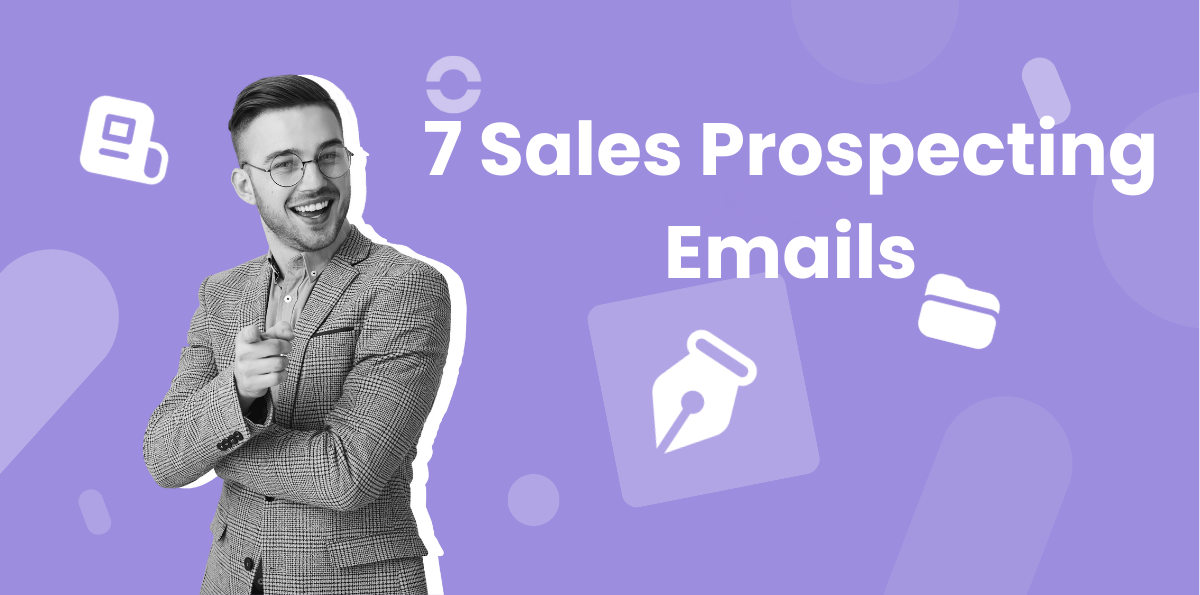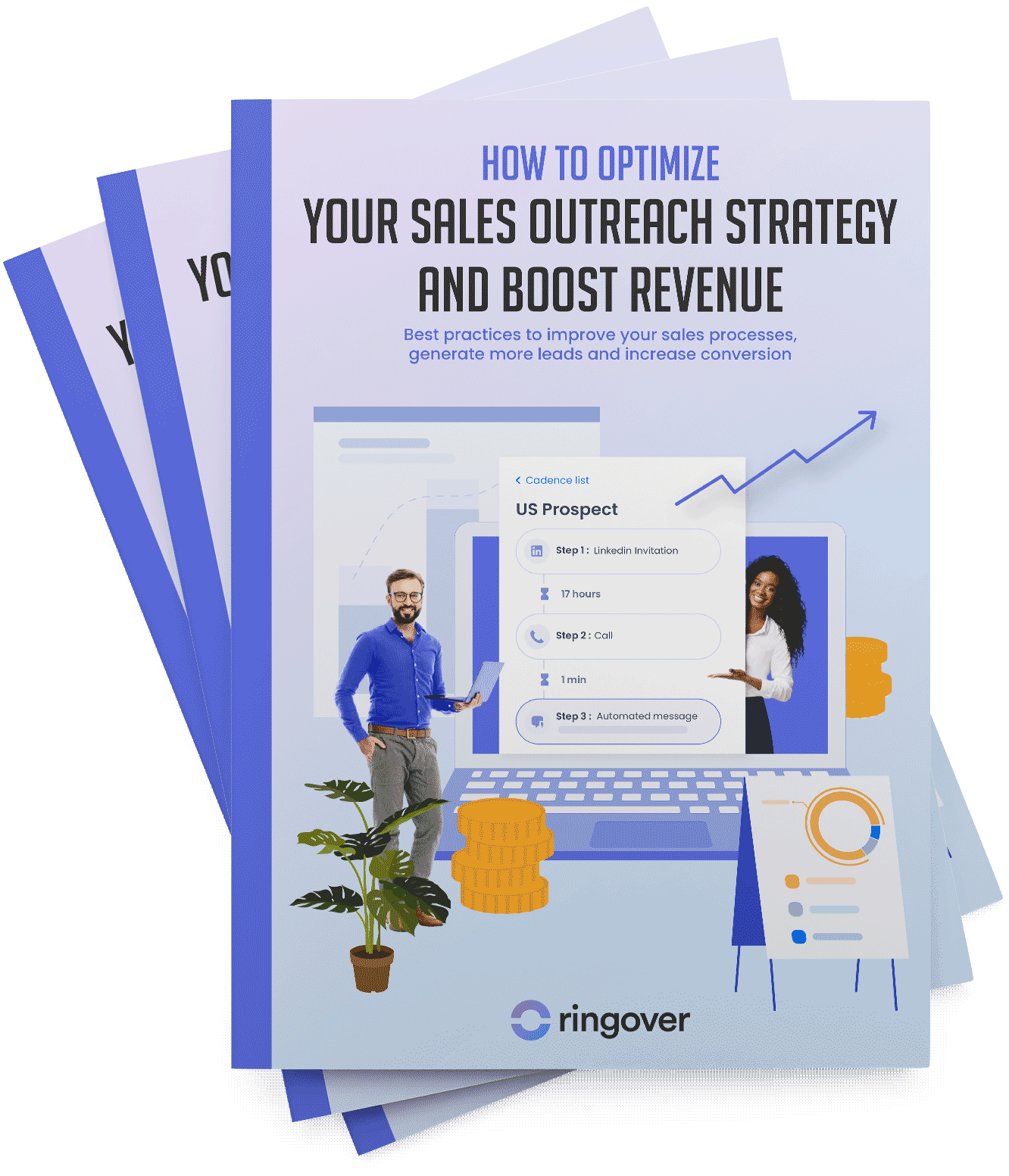Summary
So, how can you capture prospects and convince them to give you a chance? This is one of the multiple challenges that you and your competitors are regularly faced with. We're not reinventing the wheel when say that, often, an incredible product and exceptional service aren't always enough to attract potential clients.
The solution lies, first and foremost, in how you approach the prospect, particularly when you're contacting them by phone or email.
In order to help you to get your ducks in a row, ready to secure the client prise, we’ve put together a list of 7 standard emails for prospecting, which will help you to catch your contacts’ attention.
Standard prospecting emails: the first point of contact
Most of the templates that we suggest here require a certain amount of exact information regarding your targets, so reach out to your marketing team to get this information.
What information do you ideally need for initial contact?
The following information is useful for drafting an initial contact prospecting email:
- Industry the prospect works in
- Business
- Number of employees
- Last name
- First name
- Position
This information will help you to personalise your sales approach, and also to standardise it.
Example #1: Introduction email targeting the objective
For a B2B sale, it's essential that you position yourself as an expert, so that your prospect sees you as the ideal solution to eliminate or handle one or more of their pain points, and to help them achieve a business objective.Here's an example of an effective prospecting email which focuses on this objective.
Subject: Could we help you to achieve [prospect's business objective]? Hi [prospect's name],
I'm [your name], [your job title] at [your company]. We're seeing that many [prospect's job title] are struggling with [business objective] at the moment. The most common issue appears to be [issue].
I've been able to help a fair number of [prospect's job title] to overcome this obstacle, and to obtain significant results: [Relevant examples of results, such as increase in ROI, turnover, or improvements to certain processes].
Considering the specifics of your company in the [business sector] sector, the strategy that we use here at [your company] generally covers [X] steps:
- [Step 1: Handling pain point #1 with method or solution 1]
- [Step 2: Handling pain point #2 with method or solution 2]
- …
Of course, that's just a rough outline of a strategy that we'd work with you to refine in order to make sure that you achieve [business objective]. Would you be free for a few minutes this week to have a quick chat about it? What day and time would suit you?
Schedule in a meeting [link to your calendar]
Please feel free to also contact me through email or by giving me a call on [your phone number].
Kind regards, [Your email signature]
Example #2: The congratulations email (example)
Who doesn't like getting compliments? Approaching a prospect by highlighting their success is an excellent way of starting a new relationship — after all, sometimes flattery can get you anywhere. Here's an example for fundraising.
You can adapt it according to the position and the event you want to highlight (an article that's been published, a promotion, a product launch, new offices, a new project, etc.). The idea is to keep things consistent and, most importantly, relevant.
Subject: Congratulations on your [success], have you thought about [value proposal]?
Hi [prospect's name],
I'm [your name], [your job title] at [your company]. First of all, I wanted to congratulate you on the recent fundraising for [total] for [their company's name]. That's no small feat and it really stands testament to the trust that investors have in your vision.
Please correct me if I'm mistaken, but this major step will be opening up doors to new opportunities and exciting perspectives, and I believe that our expertise here at [name of your company] could play an essential role in achieving your goals.
Moreover, our [product/service] has already helped countless companies like yours to take the next step to unlock exceptional growth by optimizing [key benefit (e.g., financial management, sales process, average cart value, etc.)].
I'd be delighted to discuss this more with you, and particularly to hear more about the specificities that make you stand out in the competitive world of [prospect's industry].
Why don't we plan a call to look into how to maximise the return on this fundraising in more detail?
Schedule in a meeting [link to your calendar]
Please feel free to also contact me through email or by giving me a call on [your phone number] if you can't see a slot that suits you. I look forward to discussing this future collaboration with you.
Once again, congratulations for the remarkable fundraising achievements!
Kind regards, [Your signature]
Example #3: Problem-solving email
Subject: Is [prospect's issue which can be resolved by your product/service] posing an issue for you?
Hi [prospect name],
I'm [your name] from [your company]. I recently found out that your company is currently faced with [issue/challenge] and I believe that we have a solution which means that, together, we could effectively respond to it.
Here at [your company], we've worked with the likes of [examples of companies from the same industry as the prospect] and we really understand the degree to which [issue/challenge] can impact operational efficiency and profitability. Our solution has enabled them to [benefits provided by your solution].
Of course, each company has its specifics and that is why I'd love to talk this all through with you.
Do you have a few minutes free over the next few days for a quick phone call?
Schedule an appointment [link to your calendar] or get in touch whenever suits you.
Have a wonderful day. [Your signature]
PS: In the meantime, there is some useful information on [issue/specifics] in this [white paper/infographic/use case/guide/article] + [resource link]
Example #4: Standard prospecting email for first contact
Subject: [Name of mutual contact] suggested that I contact you
Hi [prospect's name],
I'm [your name], [your job title] at [your company].
I'm just writing to you following recommendation from [mutual contact], who I had the pleasure of meeting at [event or occasion].
[They] were enthusiastic in suggesting that we discuss [issue #1 or requirement #1 of the prospect], as they spotted an opportunity for [prospect's company].
We're already supporting multiple companies like yours, namely [company 1] and [company 2], who we've helped to overcome challenges such as [issue #1] and [issue #2].
We could pencil in a brief phone call for this morning or tomorrow. What do you think?
Please feel free to give me a call on [your number] if you're not available then.
Kind regards, [Your signature]
Examples of prospecting emails for follow-ups
The follow-up is a recurring element during the prospecting phase. It's essential if your prospect hasn't responded to your first attempt of contact (call, event, email, etc.) or if they abandon their purchasing process for x reasons.
The aim of the follow-up email is therefore to add another layer and to quickly trigger a response. Its structure is generally based around 4 points:
- An attention-catching subject
- A short introduction sentence with a personal approach
- A sentence summarizing the previous email
- A CTA
It should be specified that, if your first email hasn't gotten a response, it's recommended to leave 3 to 7 working days between these two emails. If your email still doesn't get a response, you can send a second follow-up email 15 days later.
Example #5: Standard follow-up email after a first attempt of contact
Subject: I tried to get hold of you
Hi [prospect's name],
I know how long the to-do list can get at this time of year, especially with it being [busy season example: back to school, start of the year, end of the year, etc.], and I just wanted to check that you'd received my email from [date of first email sent].
I'd love to have a quick chat with you to look at the solutions available to you for [resolving issue/achieving business objective], it'll only take around 10 minutes.
When would you be free for our chat, either over the phone or via Ringover Meet?
Kind regards, [Your email signature]
Example #6: of follow-up following a conversation
Did you get a phone appointment or were you able to chat with a prospect at an event? Sooner or later, you'll almost certainly need to follow up with them. Here's an example of a standard email:
Subject: Follow-up to our conversation on [date of conversation]
Hi [prospect's name],
I hope you're doing well.
I'm just reaching out after our conversation following the presentation of [your solution/product/service].
Other than [requirement #1 of the prospect], could [pain point #3] be a topic of interest for [pivotal period for the prospect]?
If that's the case, we could organise a meeting at your premises with our expert and the manager of your technical team, so as to better assess how we could support you.
Kind regards, [Your signature]
Example #7: of follow-up for a purchase abandon
Unfortunately, not all deals are conclusive. Yet, it's not just because your client has abandoned their purchase that you need to draw a line in the sand for all of the work you've done. It's important to acknowledge the reasons that have led the prospect to change their mind. Who knows, you may reactivate this leader later on.
Subject: Have you changed your mind on [your solution/product/service]?
Hi [name of prospect],
I see that you've decided to abandon the discussion process with [your company].
It's true that you have multiple options available to you on the market for [your sector] and that you've probably opted for another service provider.
That said, I'd still like to borrow just a few minutes of your time to discuss the reasons behind this change of mind. This would just let our team know what we can work on.
Here at [your company], we're always aiming to further improve, and your feedback would be highly appreciated.
Kind regards, [Your email signature]
A few tips for successful prospecting emails
Email remains the communication channel with the best ROI, and an email costs practically nothing. This means that you need to really exploit its full potential. To do this, here are some of our top tips:
Use a stand-out subject line
Your subject line needs to be consistent with the content of the email and your business. However, it also needs to catch your prospect's attention. So, there's a fine balance to maintain to intrigue the prospect. Opt for a catchy subject line that stands out from the masses, and never send emails with no subject or with a vague, unspecific subject line.
A good first impression is key
You need to make a good impression, and never underestimate your contact. This applies all the more in the context of prospecting, even if the prospect is familiar with your company, they don't necessarily know you personally. Introducing yourself is the least you can do, so that the prospect can put everything into context.
Give them, at the least, your full name, job title, and the company you're representing. If you don't mention your job title in the text, remember to specify it in your email signature. This signature must include your direct phone line and your email address.
Opt for contacts who already know you, whenever possible
You have more chance of getting a response from prospects who already know you personally or who have already had contact with your company. If you're cold emailing, make sure that you provide sufficient information to the prospect on how you got their email address. It's important that they don't feel intruded on.
Speak your prospect's language
Demonstrating your expertise whilst getting into technical details is good but doing it while speaking your contact's language is better.
By using your prospect's vocabulary, you're putting all of the chances on your side to create a fruitful connection with them. It's an easy way of showing that you've understood their needs. On the contrary, if you use technical terms that only specialists in your industry use regularly, you pose a risk to this relationship as the client may feel out of their depth.
Opt for refined personalisation
We can't say it enough: personalisation is key. There's no point in sending a random email, as nothing will come of it, especially in B2B, where prospects are all too familiar with the techniques of sales approaches.
So, how can you personalise your prospecting emails? To optimise the emails that you send to your future clients, it's essential that you have a certain amount of reliable information. Your marketing team has most likely collected pertinent data on each of them, and so you need to get this data.
This may be through your CRM or through a list that you add to your prospecting tool. Either way, personalisation goes beyond .csv files. Use LinkedIn and look at the different media posted by your prospect to get other information, and to hone your pitch.

Keep it short and sweet
Prospects (especially decision-making profiles) are extremely busy, and they don't have time to read long emails. So, be concise, but don't skip the essential information. Catch their attention by clearly presenting the important points, so that they can quickly understand what they have to gain from working with you.
To wrap things up, in order to maintain efficacy, switch up your approaches, personalise your messages, and keep things short and sweet whenever possible. These example prospecting emails can be used freely and are good source of inspiration but, as you'll have probably seen by now, authenticity is key to aligning with each prospect's particular profile.
So, remember to refine and adapt them whenever you send them. You can also use a prospecting tool like Cadence to add your various prospecting emails, and to discover which ones are the top performers over time. This will allow you to better organise and standardise how you prospect.
Discover now how you can reap the benefits for your business by trying Cadence out now, or by requesting a demo.


